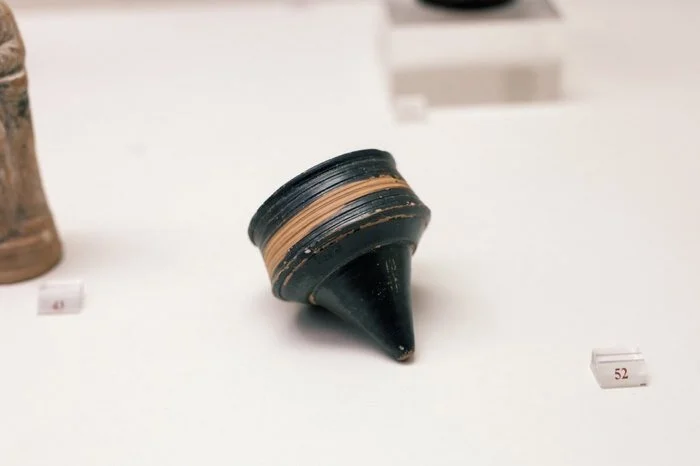At the National Archeological Museum you will find toys from ancient Greece that children still play with today.
Horse with wheels, a toy from Athens, 4th century B.C.
It was one of the favorite toys of boys, who dragged it around the house.
Rattle dog from Athens, 3rd century B.C.
The "Platagi", as it was called, was a clay rattle that was believed to fool even the evil spirits that lurked around the crib.
Clay "Plaggona"(dolls) with movable limbs, 4th and 5th century B.C.
Plaggonas were the favorite toys of girls and those with movable limbs were played with like the dolls of today. They dressed them in clothes sewn for the purpose by the women of the house.
Besides being fun, the dolls introduced the young female population to their destined roles: to be good husbands, housewives, and mothers of healthy children.
Spinning tops from the Kaverio of Thebes, 5th cent. B.C.
The spinning top was a popular toy of children and young women, as vase depictions show. But also god Hermes, the protector of children, was pictured enjoying these toys.Spinning tops have been known since prehistoric times, but they were particularly common from Archaic times. They were made of wood or, very often, clay. Some were decorated with ivy leaves or hymns or had representations of animals.
Boeotian red-shaped spool (yo-yo)
Perseus is depicted on one side and Medusa on the other. From Kaverio of Thebes, 425-400 B.C. The yo-yo consists of two disks joined in the middle by a cylindrical shaft to which they attach the beginning of a thread, which is then wound around it. If the thread is dropped, it unfolds while it is collected around the shaft again with a hand movement.
Clay dolls with movable limbs from Corinth, 5th century B.C.
The clay dolls moved like today's puppets and were also called "Daedalus" because they were attributed to Daedalus. Dolls with moving limbs were common burial objects in girls' graves, as well as offerings in shrines, along with toys. Girls dedicated the "Plaggonas"(mentioned above), along with other toys and a hairpin, on the eve of their wedding to Artemis, the protector of every transitional stage of human life and the procreation of children in androgynes, and to Aphrodite, goddess of love and fertility.
Female figurine with movable legs - Handmade
Bell-shaped body with the sculptural representation of the chest, high neck ending in a bird-shaped head. Earrings hang from the large, pierced ears. The hands in a gesture of surface or prayer are rendered as two flattened protuberances with seven fingers.
The large feet have five or six toes. There is a hanging hole at the top of the head. The red glaze was used to decorate the robe and shoes. From Thebes, early 7th century B.C. This figure was the source of inspiration for the Athenian mascots of the 2004 Olympic Games, Phoebus and Athena.















